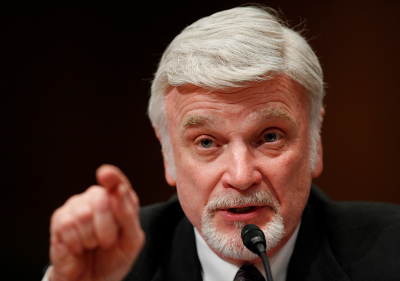
In this March 28, 2007 file photo, lignite coal is mined at the Freedom Mine in Beulah, N.D. (AP Photo/James MacPherson, File)
Earlier this week, The Associated Press put this out as big news:
Natural gas overtook coal as the top source of United States electric power generation for the first time ever this spring, a milestone that has been in the making for years as the price of gas slides and new regulations make coal riskier for power generators.
Unfortunately, in some ways, the AP story (largely a rewrite of an earlier SNL piece) buried some relevant context:
The EIA said in a May report that it expects the level of coal-generated electricity to rebound as natural gas prices rise later this year and coal-fired plants return from spring maintenance. Overall, the EIA expects about 36 percent of total U.S. electricity generation to come from coal in 2015 and 31 percent to come from natural gas.
The Guardian had some interesting thoughts on this:
In April a glut of fracked gas from new shale regions drove the price of gas down to just $2.50/million Btu (British thermal unit, a widely-used measure of energy), a 35% drop since February. This oversupply, combined with a routine seasonal shut down of coal plants, caused gas production to creep above coal for the first time.
“Power generators often use the spring months to take their plants offline for maintenance, especially coal plants. This maintenance period happened to coincide with a period of very low natural gas [prices],” said Tyler Hodge who works on the EIA’s Short-Term Energy Outlook.
Hodge said gas prices were expected to rise again in the coming months, and coal would reassert itself at the top of the production table when plants fire up again for the winter.
The back and forth is probably going to continue, but as we’ve reported here before, the long-term picture is not so good for coal, especially in Southern West Virginia.
Coal’s broader problems were made clear again today with a couple of interesting developments.
First, there was this announcement from Walter Energy:
Walter Energy, Inc. today announced that it has entered into an agreement with certain of its senior lenders on the material terms of a restructuring. To implement this pre-negotiated restructuring, Walter Energy and its U.S. subsidiaries have filed for relief under chapter 11 of the U.S. Bankruptcy Code in the Bankruptcy Court for the Northern District of Alabama. Walter Energy’s non-U.S. operations, including those in Canada and the U.K., are not included in the filings.
There’s more about this (with commentary from SNL’s Taylor Kuykendall, here. Keep in mind that Walter’s focus is mining of steel-making coal. The UMWA, which represents Walter miners in Alabama, said:
The Chapter 11 bankruptcy filing by Walter Energy is yet another indication of just how troubled the American coal industry is today. Walter does not produce coal for the energy market; it mines metallurgical-grade coal that is a raw material in steel production. Increasing competition from other countries in a shrinking worldwide steel market has caused metallurgical coal prices to plunge to levels not seen for years.
Second, there was this announcement from the Sierra Club:
Alliant Energy, a major Iowa utility, has committed to phase out coal use at six of its plants in the state, marking the 200th coal plant to shut down in the United States. This marks a milestone in the country’s transition to clean energy and underscores Iowa’s growth as a clean energy state. The announced coal plant retirements are the result of the Sierra Club’s Beyond Coal campaign advocacy, which has been a driving force in the national transition to renewable sources of power. The retirement of 200 coal plants nationwide represents the phase out of nearly 40 percent of the 523 U.S. coal plants that were in operation just five years ago. The work of Sierra Club and more than 100 allied organizations to retire these plants and replace them with clean energy has enabled the United States to lead the industrialized world in cutting global warming pollution, and has put the White House on firm footing to push for a strong international climate accord in Paris at the end of this year.
The Sierra Club added:
As coal plants are retiring at record rates, states are also making major investments in wind and solar power, fueling the transition to a clean energy economy. Iowa, for example, already generates more than a quarter of the energy powering homes and businesses from wind farms, ranking first in the nation in power generated by wind. Nearly 7,000 Iowans are now employed in the fast-growing wind energy sector, more than any other state, and Iowa has the potential to generate 100 times its current wind energy output. Iowa provides a model for neighboring states to phase out coal and capitalize on clean energy, which can also be a cost-efficient and commonsense way to meet the U.S. Environmental Protection Agency’s forthcoming Clean Power Plan requirements.
Recognizing that coal is dirty, unnecessary and increasingly uneconomical, smart utility and energy companies are transitioning to cleaner, renewable sources of energy. Clean energy sources like wind and solar have increased four-fold since 2005, as the prices for clean energy have plummeted.

 Subscribe to the Coal Tattoo
Subscribe to the Coal Tattoo














